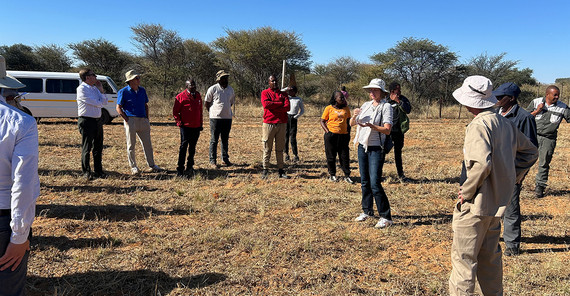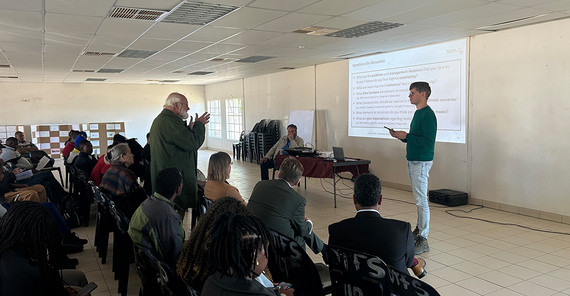Following a warm welcome by the moderator Bertus Kruger (from the Namibian National Farmers Union), Prof. Dr. Anja Linstädter opens the day with an introduction to the concept of ecological tipping points. To further present the project, we watch a short video that outlines NamTip’s goals, methods, and key results.
Dr. Stefan Liehr then presents the various factsheets developed by NamTip scientists to share key research findings and their practical and policy implications with the relevant stakeholders.Topics range from understanding tipping points and identifying indicators and causes of land degradation, to practical suggestions that farmers can use to address these challenges.
PhD student Florian Männer (from the University of Potsdam and the Frauenhofer IDG Institute) follows with a closer look at the effects of grazing pressure. He explores a range of indicators to identify reliable signs of land degradation.
Dr. Mark Bilton than dives deeper into the topic, explaining the role of perennial grasses in signalling rangeland health. He emphasizes that not all perennial grasses are signs of good conditions: four of the six most common species actually increase with degradation, while two serve as indicators of healthy ecosystems.
After a short break, Dr. Bilton continues with a talk on debushing, highlighting its benefits for rangeland restoration. This topic is expanded by Dr. Markus Rauchecker, who discusses how bush biomass can be used as a resource to generate farm income and support Namibia’s energy transition. He focuses on charcoal and woodchip production, outlining opportunities and challenges of both value chains.
After some brief but insightful presentations by school learners under the guidance of Corris Kaapehi from EduVentures, the three university representatives from NUST, UNAM, and Potsdam, including the President Prof. Oliver Günther, address the audience. All three highlight the importance of international collaboration and the strong partnerships between Namibian and German institutions.
To conclude the presentations section, Dr. Gunnar Dreßler introduces his model for analysing social-ecological dynamics. He ends by posing several questions directly to the farmers, with the aim of getting feedback on his work and to validate the model, sparking a lively and engaged discussion.
The day concludes with a field trip to the TipEx experimental site on Hamakari farm. Prof. Anja Linstädter and Dr. Mark Bilton guide the participating stakeholders through the experimental design and respond to many questions. After a final drone demonstration by Florian Männer, the group wraps up and looks forward to tomorrow’s session on managing desertification tipping points on communal land.
Link to NamTip website: https://www.uni-potsdam.de/en/namtip



